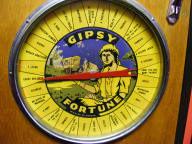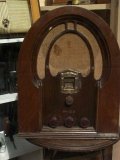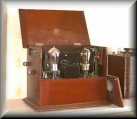'Mise-en-scène' - (APPLICATION OF THIS TERM SPECIALLY FOR RADIO DRAMA)
Literally means 'putting into the scene'.
It derives from the theatre, where it refers to the arrangement of actors, props, and action on a set. In American theatre manuals, it is stage 'picturisation'.
| REPRESENTATION of each play scene, locations, spaces, perspectives, environment - the fictional time-space |
| STYLE and MODE (as realism, non-realism, sci-fi, thriller, etc.) of the scene |
| COMPOSITION OF THE RADIO PLAY SCENE - architecture of the scene, 'picturisation', the 'frame' at any one sequence of the scene, ‘set dressing’, furniture, doors, street, inside and outside, perspective, movement |
| SOUND CENTRE - FIXED SOUND CENTRE - the centre of the sound picture remains fixed in the same place |
| SOUND CENTRE - Moving sound centre |
| MOVEMENT OF THE PLAY CHARACTERS WITHIN THE SCENE and how they relate to the 'scenery' |
How can the radio play director assure the listener of the 'reality' of 'mise-en-scène' ? What techniques to guide perception?
| LISTENER is triggered by sound events to map out the 'mise-en-scène' (scenery - environment) - techniques of ATMOS, SIGNPOSTING etc. |
| LISTENER EXPERIENCES the 'mise-en-scène' as a sort of map - outlines, edges and surfaces. |
| TOP OF THE SCENE SIGNPOSTING techniques establish the location like a film establishing shot. |
 |
| ENVIRONMENTAL information is given by Description or added words in the dialogue to fill in what is 'blind' for the listener. |
| Most solutions in REALISM are offered by radio drama Standard production (predominant style in realist radio plays). This assures the authenticity of the everyday. |
| Music gives resonance to a scene - see Music - underscoring, signature tune, emotional, dramatic |
| In ADAPTATIONS of stage plays - you work with transposing the stage scenery - compositional elements of the concrete, physical aspects of theatre. For example, the stage box set. |
 |
| Microphone positions and movement around the sound set ('blocking') are crucial. |
| LISTENER is encouraged to explore the 'mise-en-scène' from its 'centre' - FIXED SOUND CENTRE & MOVING SOUND CENTRE - 'we go with' |
| LISTENER is 'centered' by Point of listening = POL |
| Mise-en-scène usually reinforces the meanings suggested by plot, dialogue, and character. BUT in some cases, it can subvert them. Or suggest further emotions, consciously or 'unconsciously' (by nudging the listener's perception). For example, a turn of plot coming soon in the scene - distrust, sorrow, a surge of happiness. |
| 'TOTAL' mise-en-scène - using mise-en-scène to reinforce or 'nudge' the INTENSIFYING MOMENT. |
| This 'TOTAL' use of mise-en-scène can be crucial in INTENSIFYING THE MOMENT - discover the intense moments within your scenes. You convey the meaning of the scene through a single 'shot' (short sequence). |
| MORE EXAMPLES of this reinforcing or 'nudging' - building to a climax in the scene, revealing the emotional truth of a character or situation, |
| You train your awareness of the LIFEWORLD environments of sound and how these translate into the fictional worlds of radio drama. See Soundscape - An environment of SOUND (or sonic environment) with emphasis on the way it is perceived and understood by the individual, or by a society |
| FRAME - limits or boundaries of the radio play scene at any moment |
| The director can alter the first set-up of the scene frame, from that at the top of the scene. INTENSIFYING can be effected by bringing in the limits of the frame, like a tracking shot, closer to the characters. This travelling shot is termed (on this site) the 'mise-en-scène shot'. It is especially used for the climax of a scene. |
INTENSIFYING 'mise-en-scène shot' - example from film - Michelangelo Antonioni's 'The Passenger' (Professione: reporter), final scene.
| The entire final scene is a single shot, nearly eleven minutes long. |
| BEGINS inside a hotel room, CONTINUES through the window of the room into the street, TURNS to present the action that is taking place in front of the hotel. |
| Raymond Durgnat has called this 'mise-en-scène shot' in directors Cimino, Oliver Stone and Scorsese 'energy realism'. There is an unbroken, 'you are there' movement of camera and cast, the sense of mounting spectacle. |
| How could this be achieved in radio drama? |
What does LISTENER 'see'?
| The impression of 'mise-en-scène' (outlines, edges and surfaces) is more abstract geometry, rather than textured volumes and colours. |
| There is a flattening of perspective, by comparison with film, TV, and theatre. |
| The director and playwright work with the positive aspects of these restrictions. |
| Radio drama 'mise-en-scène' is psychological. 'Physical' geography is emotional geography. |
| Compare the use of highly contrasting light and shadow in paintings - CHIAROSCURO. |
| EXAMPLES - public versus private, monumental buildings, crowds, family spaces, secret spaces, places weighted down by the past, looking to the future, functional versus leisure, regulated and under control, rational and patterned versus free and spontaneous. |
| Techniques of production and acting strengthen the actors' connection to the scenic space around them. |
| See Audiences - reception theory - the listener actively constructs a story from the fictional data provided by the radio play |
| See Cognitive Mapping and Radio Drama by Alan Beck - monograph - SECTION 1 |
| See Cognitive Mapping 3.4 'Mise en scène' |
|
EXAMPLE OF 'PHYSICAL' GEOGRAPHY OF SOUND - EMOTIONAL GEOGRAPHY Argentian film - 'Garage Olimpo' - director Marco Bechis (who was tortured and uses this experience of being blindfolded in prison) 'The sound is what is autobiographical. I was held, for about ten days, in the Club Atlético, one of the camps they had in the city. […] Since I was blindfolded I didn't see anything, only once did I lift the blindfold and through some bars I saw a corridor. When I was freed and I went to Italy I sketched that corridor and with that sketch I made the stage set. The set is exactly what that sketch looked like; I gave it to a set designer and I said I want this. It's an exact reconstruction of what I saw from under my blindfold. And as for the sound, it's not that I listened to those exact songs, that radio, it's not that I heard those exact things, but what is exact is the thickness and the quality of the sound of that place, that is very much like what I remember'. Source http://www.ejumpcut.org/archive/jc48.2006/GarageOlimpo/index.html |
|
RADIO DRAMA TECHNIQUES OF REALISM Signposting - further definition Signposting - more - Signposting and establishing location THEORY DEFINITION FOR RADIO & RADIO DRAMA: Locations, spaces and perspectives for all genres of radio, but also including style and mode (as realism, non-realism, etc.). For radio drama, this involves representation of the play scene, its composition, ‘set dressing’ and perspective, and the characters’ behaviour in that environment and style. (Beck, 1999a) 'mise-en-scène' 'Mise-en-scène' in Film The term has a wider application in film, being linked to style and to 'auteur' theory. Martin, Adrian, 1990, 'Mise en scène is dead, or The Expressive, The Excessive, The Technical and the Stylish', The Australian Journal of Media & Culture, 5, no. 2, 87-140 Martin's article is no longer online, unfortunately. It was described as "remaining for me, even now, the finest and most influential piece of criticism I've ever read. The essay straddles two of Adrian's most lasting and pressing concerns: the affectual charge of aesthetic style (which he also discusses at length in 'Delirious Enchantment') and the history, politics and aesthetics of criticism itself, with its capacity to actively "conjure, perform, circulate, transform."" (Esoteric Rabbit Blog - http://www.esotericrabbit.com/blog/?p=475) |



